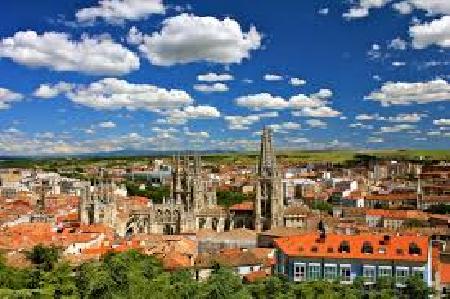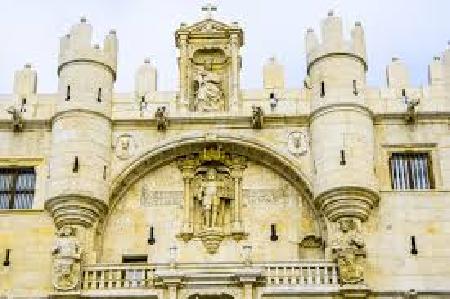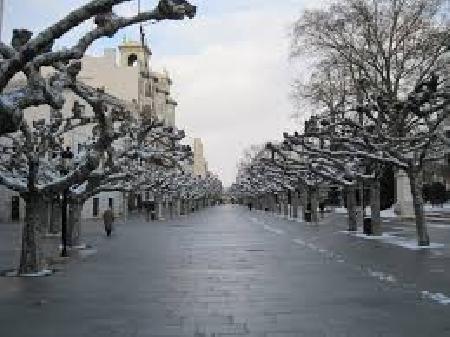 The cozy medieval city of Burgos, located in the heart of Castilla y León, 240 km north of Madrid, stands on a hill 800 meters above the picturesque Castilian plains. Burgos was for five hundred years the capital of Castilla la Vieja and the residence of the kings of Castilla. Its historical part, built in dark stone, with a castle and a cathedral, is a reminder of ancient greatness and military might.
The cozy medieval city of Burgos, located in the heart of Castilla y León, 240 km north of Madrid, stands on a hill 800 meters above the picturesque Castilian plains. Burgos was for five hundred years the capital of Castilla la Vieja and the residence of the kings of Castilla. Its historical part, built in dark stone, with a castle and a cathedral, is a reminder of ancient greatness and military might.
Burgos is known above all for its magnificent Gothic cathedral, one of the brightest examples of Spanish religious architecture. Burgos is located on a pilgrimage route to Santiago de Compostela and today you can see many monuments from different periods: medieval entrails, noble houses, elegant bridges and isolated squares.
Gate of Santa María:

At the exit of the Santa María bridge there is a door with the same name. In the 14th century, they were built on the old fortress wall, from which nothing has now been converted.
The door is a large stone tower with an arched passage. Its facade is decorated with sculptures representing famous people from Burgos and Spain, as well as statues of the Virgin Mary and the Guardian Angel of the city.
The interior of the gate towers is now equipped with showrooms. The most interesting are the Main Mudejar-style Hall and the octagonal Hall of Equality. One of the rooms houses the Pharmacy Museum, whose main exhibition is an old pharmacy.
Burgos cathedral:
To the other side of the gates of Santa María is the Plaza Santa María. Turning the main facade of this square and the famous door, there is an emblematic attraction of Burgos and of all of Spain: the Cathedral of Our Lady of Burgos.
The Cathedral is recognized as a masterpiece of Gothic architecture in Spain. The building has the shape of a Latin cross, its length reaches 84 m and its width - 59 m.
Burgos Castle:
The Burgos Castle, or rather the ruins that remain, are at the top of the San Miguel hill. To get to this attraction it is best on foot, going up through a very picturesque area and it takes 25-30 minutes. You can start from the cathedral, going up the same stairs: first along Fernán Gonzales street, then the park steps to the viewpoint, and then the path to the top of the hill.
The castle, built in 884, has long been one of the most reliable protective fortifications. It was later used as a royal residence and as a prison, and was destroyed during the 1930s civil war.
The site, which is now available to be visited, is more striking for its spirit and medieval Spanish appearance. The watchtower, 75 m above the city, offers the best views of Burgos and the Cathedral.
There is a small museum in the Castle, where behind the ropes - intact ruins of the ancient walls, there are copies of objects found here. The organization is amazing: there is no staff, just a narrator who tells the story of this place.
La Cartuja de Miraflores is a 15th century monastery complex with many buildings. Originally it was a royal hunting palace, but John II gave it to the Cartesian monastic order. As the monastery is in operation, tourists can only enter the church.
Cordon House:
This palace is located near the Santa María bridge. The palace was built in the XV century. Interestingly, the palace's name translates as "House of the Rope" (because
the portal ornament is similar to a rope, a symbol of the Franciscan monk's belt). In front of the palace there is a commemorative plaque on which it is written that in 1497 Columbus, after his second expedition to America, was received by the Kings of Castile, Isabel and Fernando. Castilla is a region of Spain, where Burgos was once the capital.
Provincial Archaeological Museum:
This three-story museum offers a large number of archaeological finds, from the Stone Age to ancient Rome. Curiously! The museum works from 10:00 to 14:00 and from 17:00 to 20:00 every day except Monday.
Paseo del Espolon:

A perfect place for a walk in the heart of Burgos, on the right bank of the Arlanzón river. The boulevard leaves from the Plaza de Teatro Arco de Santa María and ends at the Teatro de la Ciudad. Walking along this boulevard is healthy - there are buildings from different eras around it - ideal for taking photos. The street design is by the architect who designed the Burgos City Council. The boulevard is not very long, it only extends about 300 meters. In the 19th century, lime and acacia trees were planted on the boulevard. After the war with Napoleon the boulevard grew wider, began to "grow" with luxurious mansions. Queen Elizabeth II declared the boulevard a pedestrian zone and cafes and shops began to appear in the alley. In the late 19th century, a musical pergola was built on the boulevard, , which can still be seen today. In 1931 the alley was rebuilt, old trees were cut, new trees were planted, fountains and gazebos were installed, and numerous flower beds were placed. The trees on the boulevard are cut figuratively, which makes everything look very elegant.
